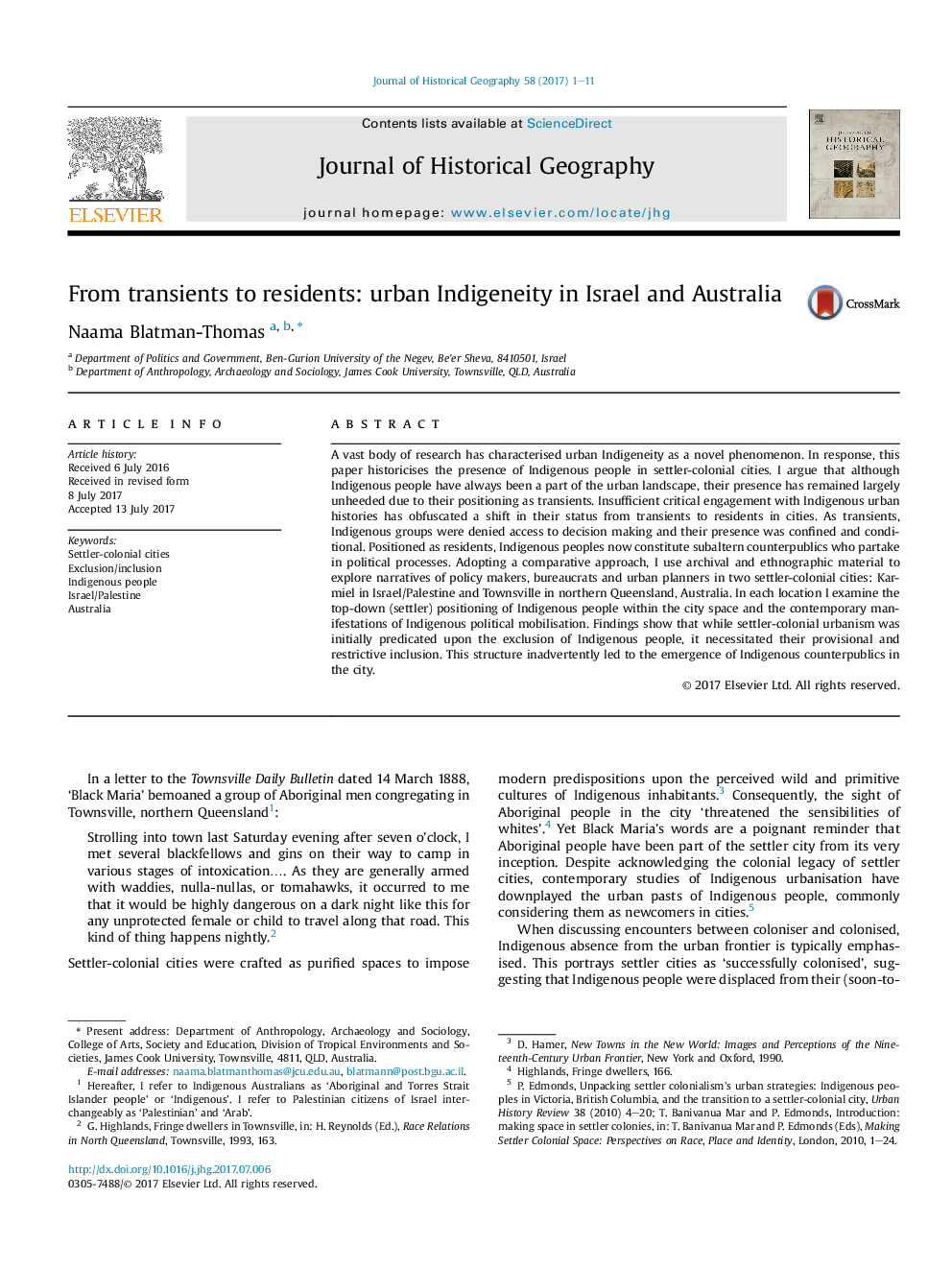| کد مقاله | کد نشریه | سال انتشار | مقاله انگلیسی | نسخه تمام متن |
|---|---|---|---|---|
| 5112894 | 1483967 | 2017 | 11 صفحه PDF | دانلود رایگان |
عنوان انگلیسی مقاله ISI
From transients to residents: urban Indigeneity in Israel and Australia
ترجمه فارسی عنوان
از گذشتگان به ساکنان: بومی بودن شهری در اسرائیل و استرالیا
دانلود مقاله + سفارش ترجمه
دانلود مقاله ISI انگلیسی
رایگان برای ایرانیان
کلمات کلیدی
شهرهای استعماری و استعماری، خروج / گنجاندن، مردم بومی، اسرائیل / فلسطین، استرالیا،
ترجمه چکیده
محدوده گسترده ای از تحقیقات، بومی بودن شهری را به عنوان یک پدیده جدید معرفی کرده است. در پاسخ، این مقاله تاریخ حضور مردم بومی در شهرهای مستعمرات استعماری را نشان می دهد. من استدلال می کنم که هرچند مردم بومی همواره بخشی از چشم انداز شهری بوده اند، اما حضور آنها تا حد زیادی از نظر موقعیت خود به عنوان گذارنده ها باقی مانده است. تعامل ناکافی بحرانی با تاریخ شهری بومی، تغییر وضعیت خود را از گذر زمان به ساکنان شهرها را مختل کرده است. به عنوان گذار، گروه های بومی از دسترسی به تصمیم گیری منع شدند و حضور آنها محدود و مشروط بود. در حال حاضر به عنوان ساکنان، مردم بومی در حال حاضر تشکیل دادگاه های ضد دموکراتیک هستند که در روند سیاسی شرکت می کنند. با استفاده از رویکرد تطبیقی، از مواد آرشیوی و قوم نگاری برای کشف روایت سیاستگذاران، بوروکراتها و برنامه ریزان شهری در دو شهر استعماری استعماری استفاده می کنم: کاریمیل در اسرائیل / فلسطین و توسانویل در شمال کوئینزلند استرالیا. در هر محل، موقعیت محلی بومیان را در فضای شهر و تظاهرات معاصر بسیج سیاسی بومی بررسی می کنم. یافته ها نشان می دهد که در حالی که شهرنشینی استعماری و استعماری در ابتدا بر محرومیت مردم بومی بستگی دارد، این امر به تدریج در مواقع قانونی و محدود کننده آنها ضروری بود. این ساختار ناخواسته منجر به ظهور ضد جمهوری های بومی در شهر شد.
موضوعات مرتبط
علوم انسانی و اجتماعی
علوم انسانی و هنر
تاریخ
چکیده انگلیسی
A vast body of research has characterised urban Indigeneity as a novel phenomenon. In response, this paper historicises the presence of Indigenous people in settler-colonial cities. I argue that although Indigenous people have always been a part of the urban landscape, their presence has remained largely unheeded due to their positioning as transients. Insufficient critical engagement with Indigenous urban histories has obfuscated a shift in their status from transients to residents in cities. As transients, Indigenous groups were denied access to decision making and their presence was confined and conditional. Positioned as residents, Indigenous peoples now constitute subaltern counterpublics who partake in political processes. Adopting a comparative approach, I use archival and ethnographic material to explore narratives of policy makers, bureaucrats and urban planners in two settler-colonial cities: Karmiel in Israel/Palestine and Townsville in northern Queensland, Australia. In each location I examine the top-down (settler) positioning of Indigenous people within the city space and the contemporary manifestations of Indigenous political mobilisation. Findings show that while settler-colonial urbanism was initially predicated upon the exclusion of Indigenous people, it necessitated their provisional and restrictive inclusion. This structure inadvertently led to the emergence of Indigenous counterpublics in the city.
ناشر
Database: Elsevier - ScienceDirect (ساینس دایرکت)
Journal: Journal of Historical Geography - Volume 58, October 2017, Pages 1-11
Journal: Journal of Historical Geography - Volume 58, October 2017, Pages 1-11
نویسندگان
Naama Blatman-Thomas,
